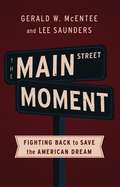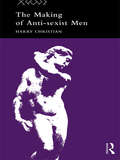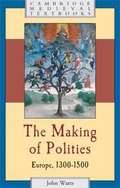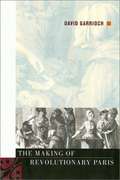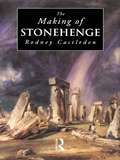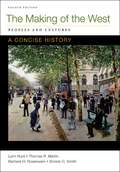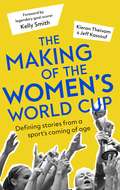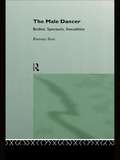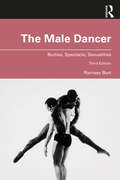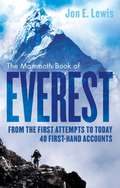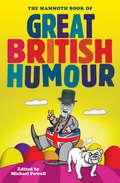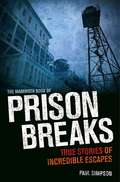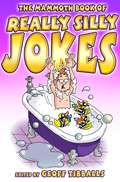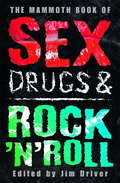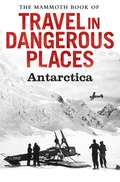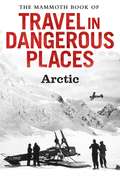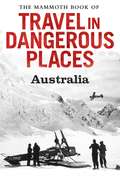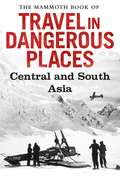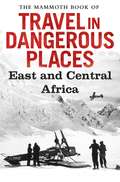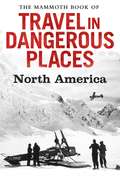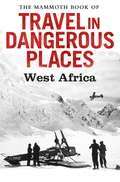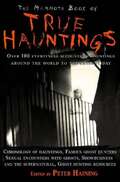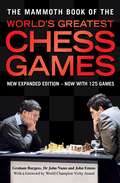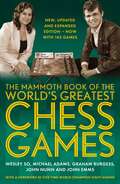- Table View
- List View
The Main Street Moment: Fighting Back to Save the American Dream
by Gerald W. Mcentee Lee SaundersIn the wake of the worst economic crisis since the Great Depression and the Supreme Court's landmark Citizens United decision, politicians are targeting working Americans as never before.<P><P>As American Federation of State, County and Municipal Employees (AFSCME) President Gerald W. McEntee and Secretary-Treasurer Lee Saunders show, efforts to crush what's left of the working middle class and the American Dream are supported by those willing to stop at nothing to enshrine profits for the few at the expense of the many. But these forces vastly underestimate the power of Americans--union and non-union alike--united for economic justice and a vibrant democracy. In fact, AFSCME's leaders argue that the response to the unprecedented attacks on the rights of workers amid growing income inequality in the United States has triggered something extraordinary: the Main Street Moment. From Washington to Wisconsin, Americans are fighting back against the crony capitalists trying to undo a century of hard-won victories for workers. These Americans know that the best bulwark against economic calamity is organized labor. Unions brought you the weekend and the forty-hour work week; unions created the middle class. And now unions must save America from those who would sacrifice democracy for the sake of profit. The Main Street Moment is the definitive manifesto for progressives and working people who know that America can only be transformed if we all stand united.
The Making of Anti-Sexist Men (Male Orders)
by Harry ChristianThe idea of the "anti-sexist man" is often treated with scorn by feminists and hesitantly by men. People are suspicious and unsure about the whole idea. Based around interviews with eight men who have responded positively to feminism, this book provides the reader with the first full length discussion of anti-sexist male attitudes. THe interviewees tell their life stories, their `making' and reveal their differences to male chauvinists. Timely and sincere, The Making of Anti-Sexist Men will appeal to all those interested in changing oppressive gender attitudes and social structures.
The Making of Polities: Europe, 1300-1500
by John WattsThis major survey of political life in late medieval Europe - the first for more than thirty years - provides an entirely new framework for understanding the developments that shaped this turbulent period. Rather than emphasising crisis, decline, disorder or the birth of the modern state, this account centres on the mixed results of political and governmental growth across the continent. The age of the Hundred Years War, schism and revolt was also a time of rapid growth in jurisdiction, taxation and representation, of spreading literacy and evolving political technique. This mixture of state formation and political convulsion lay at the heart of the 'making of polities'. Offering a full introduction to political events and processes from the fourteenth century to the sixteenth, this book combines a broad, comparative account with discussion of individual regions and states, including eastern and northern Europe alongside the more familiar west and south.
The Making of Revolutionary Paris
by David GarriochA sweeping, beautifully written, illustrated history of the world's most fascinating city--Paris--during the eighteenth century.
The Making of Stonehenge
by Rodney CastledenEvery generation has created its own interpretation of Stonehenge, but rarely do these relate to the physical realities of the monument. Rodney Castleden begins with those elements which made possible the building of this vast stone circle: the site, the materials and the society that undertook the enormous task of transporting and raising the great vertical stones, then capping them, all to a carefully contrived plan. What emerges from this detailed examination is a much fuller sense of Stonehenge, both in relation to all the similar sites close by, and in terms of the uses to which it was put. Castleden suggests that there is no one 'meaning' or 'purpose' for Stonehenge, that from its very beginning it has filled a variety of needs. The Romans saw it as a centre of resistance; the antiquaries who 'rediscovered' it in the seventeenth century saw a long line of continuity leading back into the nation's past. The archaeologists see it as a subject for rational, scientific investigation; The National Trust and English Heritage view it as an unfailing magnet for visitors; UNESCO has declared it a World Heritage Site, the cultural property of the whole of humanity. Lost to view amid competing interests over the millenia are the uses it has served for those who live within its penumbra, for whom Stonehenge has never been 'lost' or 'rediscovered'. It exists in local myth and legend, stretching back beyond history.
The Making of the West, Peoples and Cultures: A Concise History (Combined Edition-Volume I & II, 4th Edition)
by Barbara H. Rosenwein Bonnie G. Smith Lynn Hunt Thomas R. MartinWith a chronological narrative that offers a truly global context, The Making of the West: A Concise History tells the story of the cross-cultural exchanges that have shaped Western history.
The Making of the Women's World Cup: Defining stories from a sports coming of age
by Kieran Theivam Jeff KassoufWith a foreword by England legend Kelly Smith, the country's all-time record goalscorer and a player widely considered one of the best to have played the game.The exciting story of one of the fastest growing sports in the world, played by over 30 million girls and women. Over 25 million people tuned in for the Americans' 2015 Women's World Cup final victory - the most-watched football match in United States history. The Making of the Women's World Cup details the most incredible tales from previous Women's World Cups, including: Carli Lloyd's 13-minute hat trick and the worldwide movement set off by 2015How Japan made their country smile for the first time since the devastating tsunamiThe USA's World Cup triumph on home soil in 1999Germany's back-to-back titles in 2003 and 2007 Marta's magic: The birth of a Brazilian iconHow Kelly Smith announced her arrival with the kiss of a bootThe beginnings of Australia's golden generation The 122nd-minute USA equalizer against Brazil: the quarterfinal that changed everythingThe dawn of the Lionesses: England joins world elite through tears of joy and despair
The Male Dancer: Bodies, Spectacle and Sexuality
by Ramsay BurtIn this challenging and lively book, Ramsay Burt examines the representation of masculinity in twentieth century dance. Taking issue with formalist and modernist accounts of dance, which dismiss gender and sexuality as irrelevant, he argues that prejudices against male dancers are rooted in our ideas about the male body and male behaviour. Building upon ideas about the gendered gaze developed by film and feminist theorists, Ramsay Burt provides a provocative theory of spectorship in dance. He uses this to examine the work of choreographers like Nijinsky, Graham, Bausch, while relating their dances to the social, political and artistic contexts in which they were produced. Within these re-readings, he identifies a distinction between institutionalised modernist dance which evokes an essentialist, heroic, `hypermasculinity'; one which is valorised with reference to nature, heterosexuality and religion, and radical, avant garde choreography which challenges and disrupts dominant ways of representing masculinity. The Male Dancer will be essential reading for anyone interested in dance and the cultural construction of gender.
The Male Dancer: Bodies, Spectacle, Sexualities
by Ramsay BurtThis revised third edition of The Male Dancer updates and enlarges a seminal book that has established itself as the definitive study of the performance of masculinities in twentieth century modernist and contemporary choreography. In this authoritative and lively study, Ramsay Burt presents close readings of dance works from key moments of social and political change in the norms around gender and sexuality. The book’s argument that prejudices against male dancers are rooted in our ideas about the male body and behaviour has been extended to take into account recent interdisciplinary discussions about whiteness, intersectionality, disability studies, and female masculinities. As well as analysing works by canonical figures like Nijinsky, Graham, Cunningham, and Bausch, it also examines the work of lesser-known figures like Michio Ito and Eleo Pomare, as well as choreographers who have recently emerged internationally like Germaine Acogny and Trajal Harrell. The Male Dancer has proven to be essential reading for anyone interested in dance and the cultural representation of gender. By reflecting on the latest studies in theory, performance, and practice, Burt has thoroughly updated this important book to include dance works from the last ten years and has renewed its timeliness for the 2020s.
The Mammoth Book Of Everest: From the first attempts to today, 40 first-hand accounts
by Jon E. LewisThis selection of the very best writing on Everest begins with the first attempts and continues, via Mallory's failed bid and Hillary and Tenzing's triumph, to the disasters of recent years. It features 35 white-knuckle accounts of climbing on the world's highest mountain, with all the tragedy and triumph of humankind's striving for the top of the world, by those who know the 'Death Zone' best - the climbers themselves. But this is much more than just the best of exhilarating first-hand accounts of climbing on Everest. It includes the full history of the conquest of Everest, and provides an evocative portrait of the cruel, natural beauty of Chomolungma, 'The Mother Goddess of the World'.
The Mammoth Book of Great British Humour (The Mammoth Bks.)
by Michael PowellA doorstopper of a collection of the very best of both contemporary and classic British wit and humour. From Monty Python's 'Nudge, nudge, wink, wink, say no more . . .' to Dan Antopolski's 'Hedgehogs. Why can't they just share the hedge?'. From George Bernard Shaw to Michael McIntyre, from Eric Morecombe to Omid Djalili, and from Oscar Wilde to Jimmy Carr, a side-splitting look at Britain, the British and life in general. Including these gems from Britain's finest comedians:I was delighted to learn that my friend's schadenfreude was not as satisfying as mine. Armando Iannucci.I went on a girls' night out recently. The invitation said 'dress to kill'. I went as Rose West. Zoe LyonsFor a while I was the perfect mother. Then the Pethidine wore off. Jenny Eclair.My girlfriend was complaining last night that I never listen to her. Or something like that. Jack Dee.Why do dogs always race to the door when the doorbell rings because it's hardly ever for them? Harry Hill.Arse-gravy of the very worst kind. Stephen Fry on The Da Vinci Code.You have to come up with this shit every year. Last week I just wrote "I still love you, see last year's card for full details." Michael McIntyre on Valentines Day.I went to the doctor and he said, 'You've got hypochondria.' I said, 'Not that as well!'Tim Vine.I have the body of an eighteen year old. I keep it in the fridge. Spike Milligan.When someone close to you dies, move seats. Peter Kay.My neighbour asked if he could use my lawnmower and I told him of course he could, so long as he didn't take it out of my garden. Eric Morecambe.My dad's dying wish was to have his family around him. I can't help thinking he would have been better off with more oxygen. Jimmy Carr.Eighty-two point six per cent of statistics are made up on the spot. Vic Reeves.A bird in the hand invariably shits on your wrist. Billy Connolly.Getting divorced isn't like a bereavement at all, because if he's died, I'd have had me mortgage paid, and I could've danced on his grave. Sarah Millican.My greatest hero is Nelson Mandela: incarcerated for 25 years, he was released in 1990, he's been out about 18 years now and he hasn't re-offended. Ricky Gervais.If you want to confuse a girl, buy her a pair of chocolate shoes. Milton Jones.Phil Collins is losing his hearing, making him the luckiest man at a Phil Collins Concert. Simon Amstell.We'll continue our investigation into the political beliefs of nudists. We've already noticed a definite swing to the left. Ronnie Barker.A guy walks into the psychiatrist wearing only Clingfilm for shorts. The psychiatrist says, "Well, I can clearly see your nuts. Tommy Cooper
The Mammoth Book of Prison Breaks
by Paul SimpsonTrue stories of prison breaks including those of Frank Abagnale, whose story is told in Catch Me If You Can; Henri Charrière who claimed to have escaped from the supposedly inescapable Devil's Island - the true story as opposed to his questionable memoir, Papillon; Bud Day, said to be the only US serviceman ever to have escaped to South Vietnam; the six prisoners who escaped from Death Row in Mecklenburg Correctional Center; and Pascal Payeret, the French armed robber who escaped not once, but twice from French prisons with the help of a helicopter.
The Mammoth Book of Really Silly Jokes: Humour for the whole family (The Mammoth Bks.)
by Geoff TibballsThe biggest and best collection of jokes for all the family to enjoy. 8,000 rib-ticklers, covering every subject under the sun from Aardvarks to Zombies, including chicken jokes, doctor-doctor jokes, elephant jokes, horror jokes, knock-knock jokes, excruciating puns, riddles, school jokes, sports jokes and waiter jokes. Most of the jokes are sharp one-liners but there is also a scattering of slightly longer stories.
The Mammoth Book of Sex, Drugs & Rock 'n' Roll
by Jim DriverOver 60 gripping accounts tracking the dark side of rock 'n' roll from the early days of the drugs-and-drink culture, and the birth of rock 'n' roll, through The Beatles, Stones, Sex Pistols, Madonna, Kurt Cobain and Oasis, to Amy Winehouse, Pete Doherty and other stars of the current rock-music scene.From trashed hotel rooms to cars in swimming pools, all rock 'n' roll's excesses are here, including murder and sexual deviancy, surprising brushes with the law that the stars thought they'd kept quiet, early and tragic deaths, drug overdoses, robbery, mis-marriages and groupies by the truckload
The Mammoth Book of Travel in Dangerous Places: Antarctic
by John KeayFarthest South - Ernest Henry ShackletonBorn in Ireland, Shackleton joined the merchant navy before being recruited for Captain Scott's 1901 expedition to Antarctica. He was with Scott on his first attempt to reach the South Pole and, though badly shaken by the experience, realized that success was now feasible. In 1907, with a devoted team but little official support, he launched his own expedition. A scientific programme gave it respectability but Shackleton was essentially an adventurer, beguiled alike by the challenge of the unknown and the reward of celebrity. His goal was the Pole, 90 degrees south, and by Christmas 1908 his four-man team were already at 85 degrees.The Pole at Last - Roald AmundsenAmundsen's 1903-6 voyage through North West Passage had heralded a new era in exploration. The route by then was tolerably well known and its environs explored. His vessel was a diminutive fishing smack, his crew a group of Norwegian friends, and his object simply to be the first to have sailed through. He did it because it had not been done and "because it was there". The same applied to his 1911 conquest of the South Pole. Shackleton had shown the way and Amundsen drew the right conclusions. The Pole was not a scientist's playground nor a mystic's dreamland; it was simply a physical challenge. Instead of officers, gentlemen and scientists, he took men who could ski and dogs that could pull; if need be, the former could eat the latter. The only real anxiety was whether they would forestall Scott.In Extremis - Robert Falcon ScottScott was chosen to lead the 1900-4 British National Antarctic Expedition. Its considerable achievements seemed to vindicate the choice of a naval officer more noted for integrity and courage than any polar experience, and, following Shackleton's near success, in 1910 Scott again sailed south intending to combine a busy scientific programme with a successful bid for the South Pole. On 17 January 1912 he and four others duly reached the Pole, indeed they sighted a real pole and it bore a Norwegian flag; Amundsen had got there 34 days ahead of them. Bitterly disappointed, soon overtaken by scurvy and bad weather, and still dragging sledges laden with geological specimens, they trudged back. The tragedy which then unfolded eclipsed even Amundsen's achievement and won them an immortality beyond the dreams of any explorer.
The Mammoth Book of Travel in Dangerous Places: Arabia
by John KeayEscape from Riyadh - William Gifford PalgraveA scholar and a solider, a Jesuit and a Jew, a French spy and a British ambassador- Palgrave was a man of contradictions, all of them highly compromised when in 1862-3, fortified by Pius IX's blessing and Napoleon III's cash, he attempted the first west- east crossing of the Arabian peninsular. To steely nerves and a genius for disguise he owed his eventual success; but not before both were sorely tested when, as a Syrian doctor, he became the first European to enter Riyadh. The desert capital of the fanatical Wahabis, dangerous for an infidel at the best of times, was then doubly so as the sons of the ageing King Feisal intrigued for power.Desert Days - Charles Montagu DoughtyDuring two years (1875-7) wandering in Central Arabia Doughty broke little new ground; dependant on desert charity, his achievement was simply to have survived. Yet his book, Arabia Deserta, was instantly recognized as a classic. Its eccentric prose proves well suited to that minute observation and experience of Bedouin life which was Doughty's main contribution to exploration. T.E. Lawrence called it "a bible of a kind"; both syntax and subject matter have biblical resonances, as in this description of a day's march, or rahla.
The Mammoth Book of Travel in Dangerous Places: Arctic
by John KeayFour Years in the Ice - John RossDisgraced and dishonored for his report of an imaginary mountain range blocking the most likely access to the North West Passage, in 1829 Ross returned to Canada's frozen archipelago to vindicate his reputation. He rounded the north of Baffin Island and entered what he named the Gulf of Boothia. Here the Victory, his eccentric paddle-steamer, became frozen to the ice. Through three tantalizingly brief summers the expedition tried to find a way out and through four long winters then endured the worst of Arctic conditions in a makeshift camp. In July 1832, with the ship long since abandoned, Ross made what must be their last bid to reach open water.Living off Lichen and Leather - John FranklinIn 1845, looking again for the North West Passage, two well-crewed ships under Franklin's command sailed into the Canadian Arctic and were never seen again. There began the most prolonged search ever mounted for an explorer. For Franklin had been lost before and yet had survived. In 1821, returning from an overland reconnaissance of the Arctic coast north of Great Slave Lake, he and Dr. John Richardson, with two Lieutenants and about a dozen voyageurs (mostly French), had run out of food and then been overtaken by the Arctic weather. Franklin's narrative of what is probably the grisliest journey on record omits unpalatable details, like the cannibalism of one of his men, the murder of Lieut. Hood, and Richardson's summary shooting of the murderer; but it well conveys the debility of men forced to survive on leather and lichen (triple de roche) plus that sense of demoralization and disintegration that heralds the demise of an expedition.Adrift on an Arctic Ice Floe - Fridtjof Nansen Norwegian patriot, natural scientist, and Nobel laureate, Nansen caught the world's imagination when he almost reached the North Pole in 1895. The attempt was made on skis from specially reinforced vessel which, driven into the ice, was carried from Siberia towards Greenland. The idea stemmed from his first expedition, an 1888 crossing of Greenland. Then too he had used skis and then too, unwittingly and nearly disastrously, he had taken to the ice. Arrived off Greenland's inhospitable east coast, he had ordered his five-man party to spare their vessel by crossing the off-shore ice floe in rowing boats. A task which he expected to take a few hours turned into an involuntary voyage down the coast of twelve days.The Pole is Mine - Robert Edwin Peary Born in Pennsylvania and latterly a commander in the US navy, Peary had set his sights on claiming the North Pole from childhood. It was not just an obsession but a religion, his manifest destiny. Regardless of cost, hardship, and other men's sensibilities, he would be Peary of the Pole, and the Pole would be American. Critics might carp over the hundreds of dogs that were sacrificed to his ambition, over the chain of supply depots that would have done credit to a military advance, and over the extravagance of Peary's ambition, but success, in 1909, came only after a catalogue of failures; and even then it would be disputed. Under the circumstances his triumphalism is understandable and, however distasteful, not unknown amongst other Polar travelers.
The Mammoth Book of Travel in Dangerous Places: Australia
by John KeayLandfall at Botany Bay - James CookThe son of a Yorkshire farm labourer, Cook won distinction as a naval hydrographer but was still a controversial choice to command a voyage of scientific observation to the Pacific in 1768. Its results, including the first coastal surveys of New Zealand and eastern Australia, led to a second voyage to the south Pacific and a third to the north Pacific, during which he was killed in a fracas with the Hawaiians. It was a tragic end for one whose humble origins disposed him to respect indigenous peoples. "They are far happier than we Europeans", he noted of Australia's aborigines following a brief encounter at Botany Bay (Sydney), the first European landing on the Pacific coast, in 1770.Escape from the Outback - Charles SturtAfter pioneering journeys to the Darling and Murray rivers, in 1844-5 Sturt headed north for the heart of Australia. Since the continent appeared to have few seaward draining rivers it was assumed that, alike Africa, it must boat an inland lake region; a boat was therefore included amongst the expeditions equipment. But Sturt failed to reach the geographical centre of the continent, and the largest stretch of water found was at Coopers Creek, later to figure so prominently in the endeavours of Burke and Wills. Sturt's painful retreat during the hottest summer on record formed a fitting prelude to the Wills saga.Death at Coopers Creek - William John WillsIn early 1861 Robert O'Hara Burke, William Wills and John King reached Australia's northern coast on the Gulf of Carpentaria, thus completing the first transcontinental crossing. Returning the way they had come, after four months of appalling hardship they staggered into Sturt's Coopers Creek where men and supplies had been left to await their return. They were just eight hours too late; the relief party, despairing of their return, had left that very morning. One of exploration's most poignant moments was followed by one of its most protracted tragedies as the expedition tried to extricate itself, failed, faded, and died. Only King survived; three months later he was discovered living with the aborigines; Will's heartbreaking journal was found lying beside his skeleton.To See the Sea - John McDouall StuartModest, dedicated, immensely tough and thoroughly congenial, Stuart was very much an explorer's explorer. With little support or fuss he began probing north from Adelaide in the late 1850's. In 1860 he was the first to reach the centre of the continent, thus completing the work of Sturt. Although Burke and Wills just beat him in the race to cross the continent, Stuart's 1862 route was much longer and more difficult; and he did actually reach the sea. He was also to return alive.
The Mammoth Book of Travel in Dangerous Places: Central and South Asia
by John KeayAlarms amongst the Uzbeks - Alexander BurnesOf all the "forbidden" cities (Timbuktu, Mecca, Lhasa, Riyadh and so on) none enjoyed a more fearsome reputation that Bukhara in Uzbekistan. The first British Indian expedition, that of William Moorcroft in 1819-26, had never returned. Moorcroft's disappearance, like that of Livingstone or Franklin, posed a challenge in itself and preyed on the minds of his immediate successors. Heavily disguised and in an atmosphere of intense intrigue, Burnes and Dr James Gerard crossed the Afghan Hindu Kush in 1832 and approached the scenes of Moorcroft's discomfiture. They would both return; and "Bukhara Burnes" would become the most renowned explorer of his day.On the Roof of the World - John WoodIn 1937 Alexander Burnes returned to Afghanistan on an official mission. Amongst his subordinates was a ship's lieutenant who, having surveyed the navigational potential of the river Indus, took off on a mid-winter excursion into the unknown Pamirs between China and Turkestan. Improbably, therefore, it was John Wood, a naval officer and the most unassuming of explorers, who became the first to climb into the hospitable mountain heartland of Central Asia and the first to follow to its source the great river Oxus (or Amu Darya.)Exploring Angkhor - Henri MouhotBorn in France, Mouhot spent most of his career in Russia as a teacher and then in the Channel Islands. A philologist by training, he also took up natual history and it was with the support of the Royal Zoological Society that in 1858 he set out for South East Asia. From Siam (Thailand) he penetrated Cambodia and Laos, where he died; but not before reaching unknown Angkhor and becoming the first to record and depict the most extensive and magnificent temple complex in the world. His discovery provided the inspiration for a succession of subsequent French expeditions up the Mekong.Over the Karakorams - Francis Edward YounghusbandAs leader of the 1904-5 British military expedition to Lhasa and as promoter of the early assaults on Mount Everest, Younghusband came to epitomize Himalayan endeavour. To the mountain he also owed his spiritual conversion from gung-ho solider to founder of the World Congress of Faiths. His initiation came in 1887 when, as the climax to journey from Peking across the Gobi desert, he determines to reach India over the unexplored Mustagh Pass in the Karakorams - "the most difficult and dangerous achievement in these mountains so far" (S.Hedin).Trials in Tibet - Ekai KawaguchiBy the 1890's the capital of "forbidden" Tibet, unseen by a foreigner since Huc's visit, represented the greatest challenge to exploration. Outright adventurers like the dreadful Henry Savage Landor competed with dedicated explorers like Sven Hedin, all succumbed to to a combination of official vigilance and physical hardship. The exception, and the winner in "the race for Lhasa", was a Buddhist monk from Japan whose expedition consisted of himself and two sheep. Ekai Kawaguchi was supposedly a pilgrim seeking religious texts. His faith was genuine and often tested, as during this 1900 excursion into western Tibet; but he is also thought to have been an agent of the British government in India.
The Mammoth Book of Travel in Dangerous Places: East and Central Africa
by John KeayAmong the Sudanese - James BruceBruce reached the source of the Blue Nile in 1771, a century before the search for the source of the White Nile became headline news. His descriptions of the cruelties and orgies at Gondar, the Ethiopian capital, were greeted with disbelief; so was his account of the Sudanese rulers, and their queens, at Sennar. He was later shown to be an accurate observer as well as the eighteenth century's most intrepid traveller.Not the Source of the Nile - Richard Francis BurtonIn Burton a brilliant mind and dauntless physique were matched with a restless spirit and a deeply troubled soul to produce the most complex of characters. Contemptuous of other mortals, including Speke, his companion and rival, he found solace only in the extremities of erudition and adventure. A Glimpse of Lake Victoria - John Hanning SpekeIn July 1858, while returning from Lake Tanganyika with Burton, Speke made a solo excursion to the north in search of an even larger lake reported by an Arab informant. Although partially blind and unable to ascertain its extent, he named this lake "Victoria" and boldly declared it the long sought source of the White Nile. The Reservoir of the Nile - Samuel White BakerAmongst professional explorers and big game hunters, none was as successful as Baker. A bluff and plausible figure, wealthy and resourceful, he conducted his explorations on the grand scale, invariably reached his goal and invariably reaped the rewards.Last Days - David LivingstoneLivingstone was nurtured in poverty and religious fervour. He reached southern Africa as a missionary doctor but, more suited to solitary exploration, edged north in a series of pioneering journeys into the interior. Encounters on the Upper Congo - Henry Morton StanleyStanley made his name as an explorer by tracking down Livingstone in 1871. But obscure Welsh origins, plus the adoption of US citizenship and professional journalism, did not endear him to London's geographical establishment. His response was to out-travel all contemporaries, beginning with the first ever coast-to-coast crossing of equatorial Africa. A Novice at Large - Joseph ThomsonBarely twenty and just out of Edinburgh University, Thompson was unexpectedly employed on the Royal Geographical Society's 1878 expedition to the Central African lakes. Unlike Burton he admired Africans; unlike Stanley he would not fight them. His motto - "he who goes slowly, goes safely; he who goes safely, goes far" - was never more seriously tested that when, just six weeks inland from Dar es Salaam, his first expedition lost Keith Johnston, its leader and Thompson's only European companion.
The Mammoth Book of Travel in Dangerous Places: North America
by John KeayFirst Crossing of America - Alexander Mackenzie"Endowed by nature with an acquisitive mind and an enterprising spirit", Mackenzie, a Scot engaged in the Canadian fur trade, resolved, as he out it "to test the practicability of penetrating across the continent of America". In 1789 he followed a river (the Mackenzie) to the sea; but it turned out to be the Arctic Ocean. He tried again in 1793 and duly reached the Pacific at Queen Charlotte Sound in what is now British Columbia. Although this was his first recorded overland crossing of the continent, Mackenzie was not given to trumpeting his achievement. In his narrative it passes without celebration and very nearly without mention.Meeting the Shoshonee - Meriwether LewisAs Thomas Jefferson's personal secretary, Lewis was chosen to lead the US government's 1804-5 expedition to explore (and to establish US interests) from Mississippi to the Pacific. Travelling up the Missouri river to the continental divide in Montana, Lewis left the main party under his colleague William Clark, and scouted ahead. With everything now dependant on securing the goodwill of the formidable Shoshonee, he showed admirable caution; but the issue was eventually decided by a fortuitous reunion between the Indian wife of one of his men and her long-lost brethren.
The Mammoth Book of Travel in Dangerous Places: West Africa
by John KeayAlone in Africa - Mungo ParkPark's 1795-7 odyssey in search of the Niger first awakened the world to the feasibility of a white man penetrating sub-Saharan Africa. But unlike his illustrious successors, this quiet tenant farmer's son from the Scottish Borders travelled alone; relieved of his meager possessions, he was soon wholly dependant on local hospitality. In what he called "a plain unvarnished tale" he related horrific ordeals with admirable detachment - never more tested than on his return journey through Bamako, now the capital of Mali.The Road to Kano - Hugh ClappertonIn one of exploration's unhappier sagas two Scots, Captain Hugh Clapperton and Dr. Walter Oudney, were saddled with the unspeakable Major Dixon Denham on a three year journey to Lake Chad and beyond. Clapperton mapped much of northern Nigeria and emerged with credit. Major Denham also excelled himself, twice absconding, then accusing Oudney of incompetence and Clapperton of buggery. Happily the Major was absent in 1824, after nursing his dying friend, Clapperton became the first European to reach Kano.Down the Niger - Richard LanderAs Clapperton's manservant, Lander attended his dying master on his 1825 expedition to the Niger and was then commissioned, with his brother John, to continue the exploration of the river. The mystery of its lower course was finally solved when in 1831 they sailed down through Nigeria to the delta and the sea. Unassuming Cornishmen, the Landers approached their task with a refreshing confidence in goodwill of Africans. It paid of in a knife-edge encounter at the confluence of the Benoue, although Richard subsequently paid the price with his life.Arrival in Timbuktu - Heinrich BarthBorn in Hamburg, Barth was already an experienced traveler and a methodical scholar when in 1850 he joined a British expedition to investigate Africa's internal slave trade. From Tripoli the expedition crossed the Sahara to Lake Chad. Its leader died but Barth continued on alone, exploring vast tract of the Sahel from northern Cameroon to Mali. Timbuktu, previously visited only by A.G. Laing and René Caillié, provided the climax as Barth, in disguise, approached the forbidden city by boat from the Niger.My Ogowé Fans - Mary KingsleySelf-educated while she nursed her elderly parents, Mary Kingsley had known only middle-class English domesticity until venturing to West Africa in 1892. Her parents had died and, unmarried, she determined to study "fish and fetish" for the British Museum. Her 1894 ascent of Gabon's Ogowé River (from Travels in West Africa, 1897) established her a genuine pioneer and an inimitable narrator. She died six years later while nursing prisoners during the Boer War.
The Mammoth Book of True Hauntings (Mammoth Books)
by Peter HainingThis giant collection includes a huge range of 20th-century first-hand accounts of hauntings, such as the American troops who repeatedly saw the ghosts of a dead platoon of men while on patrol in Vietnam; and the witnessed haunting of a house near Tintagel in Cornwall that led actress Kate Winslet to pull out of buying the property.It covers the full spectrum of credible hauntings, from poltergeists (the noisy, dangerous and frightening spirits that are usually associated with pubescent girls, like the Bell Witch), to phantoms (like the Afrits of Saudi Arabia) and seduction spirits (such as the Lorelei, which have lured German men to death).Also included are the notes of the most famous ghost hunters of the twentieth century such as Hans Holzer, Susy Smith (USA); Harry Price, Jenny Randles (UK); Joyce Zwarycz (Australia), Eric Rosenthal (South Africa), and Hwee Tan (Japan). Plus essays by such names as Robert Graves, Edgar Cayce, and M. R. James outlining their own - often extraordinary - conclusions as to just what ghosts might be; along with a full bibliography and list of useful resources.Praise for MBO Haunted House Stories:'A first rate list of contributors ... Hair raising!' Time Out'All we need say is buy it.' Starlog
The Mammoth Book of the World's Greatest Chess Games: New edn
by Graham Burgess John Nunn John EmmsThe 125 greatest chess games of all time, selected, analysed, re-evaluated and explained by a team of British experts and illustrated with over 1,000 chess diagrams. Join the authors in studying these games, the cream of two centuries of international chess, and develop your own chess-playing skills - whatever your current standard. Instructive points at the end of each game highlight the lessons to be learned.First published in 1998, a second edition of The Mammoth Book of the World's Greatest Chess Games in 2004 included an additional 12 games. This edition includes a further 13 games as well as some significant revisions to the analysis and information regarding other games in earlier editions of the book, facilitated by the use of a variety of chess software.
The Mammoth Book of the World's Greatest Chess Games: New edn
by Michael Adams Graham Burgess John Nunn John Emms Wesley SoImprove your chess by studying the greatest games of all time, from Adolf Anderssen's 'Immortal Game' to Magnus Carlsen's world championship victories, and featuring a foreword by five-times World Champion Vishy Anand.This book is written by an all-star team of authors. Wesley So is the reigning Fischer Random World Champion, the 2017 US Champion and the winner of the 2016 Grand Chess Tour. Michael Adams has been the top British player for the last quarter of a century and was a finalist in the 2004 FIDE World Championship. Graham Burgess is the author of thirty books, a former champion of the Danish region of Funen, and holds the world record for marathon blitz chess playing. John Nunn is a three-time winner of both the World Solving Championship and the British Chess Federation Book of the Year Award. John Emms is an experienced chess coach and writer, who finished equal first in the 1997 British Championship and was chess columnist of the Young Telegraph.The 145 greatest chess games of all time, selected, analysed, re-evaluated and explained by a team of British and American experts and illustrated with over 1,100 chess diagrams. Join the authors in studying these games, the cream of two centuries of international chess, and develop your own chess-playing skills - whatever your current standard. Instructive points at the end of each game highlight the lessons to be learned.First published in 1998, a second edition of The Mammoth Book of the World's Greatest Chess Games in 2004 included an additional twelve games. Another new edition in 2010 included a further thirteen games as well as some significant revisions to the analysis and information regarding other games in earlier editions of the book, facilitated by the use of a variety of chess software. This 2021 edition, further updated and expanded, now includes 145 games.The authors have made full use of the new generation of chess analysis engines that apply neural-network based AI.
